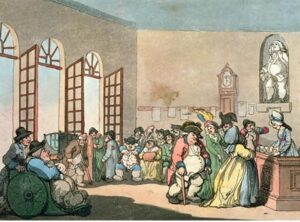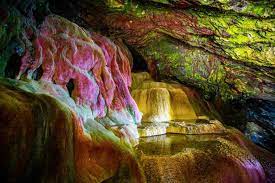Dr Charlotte MacKenzie, regular Cornish Story contributor, is a prolific writer and speaker on Cornish History and here she turns her attention to that most absorbing of subjects, Cornish Legends.

To what extent was Cornish folklore recorded before the collection and publication of folk tales by Victorian folklorists? Some customary practices were mentioned from the seventeenth century onwards. I am delighted that my current research on folklore and healthcare in Georgian Cornwall has a grant from the Q fund. Here, I explore some of the historical interconnections between Cornish wells, folklore, and healthcare.
The quest for improved health was one of the reasons Georgians travelled from home, promoting the development of fashionable spas in Britain and Europe. Many educated Georgians placed their trust in the health benefits of spa waters, which were advocated by medical practitioners. Some great Cornish landowners and gentry, who had no faith in holy wells in Cornwall, travelled to Bath or other spas to take the waters for their health. Letters, journals, and household accounts confirm that it was common for individuals in Cornwall, who could afford to do so, to travel to Bath. As two Cornish vicars and published authors, William Borlase and Richard Polwhele, each did.
Cornish folklore attributed health-giving properties to wells which had been identified as holy in Christian traditions. Georgian gentlemen who noted Cornish customs at holy wells and ancient sacred sites were mostly dismissive of what they saw as credulity and superstition. The continuance of which they associated with the uneducated and the poor.
William Borlase’s curiosity about Cornish wells and waters related to several aspects of his personal experience and intellectual interests, and was not primarily focused on customary practices, the continuation and presence of which he acknowledged.
When aged in his mid 30s, William Borlase suffered pain in some joints, which improved following a visit to the hot spring spa of Bath. Where Borlase placed himself under the care of his friend and physician William Oliver, who originated from Ludgvan in Cornwall.
Borlase was an Anglican. A Georgian vicar who joined in with and enjoyed what he described as the ‘frolicking’ society of life in Cornwall; while declining to participate in the landowner sports of hunting or shooting. Borlase was an antiquarian, whose detailed drawings and descriptions of the antiquities where he lived remain of current interest; while his discussion of Druids and paganism has been largely superseded.
Borlase occupied the vicarage in Ludgvan for half a century, overlooking Mount’s Bay, where he was a keen gardener and observer of the weather. He had an active interest in scientific investigations and discoveries. He was an elected member of the Royal Society, publishing papers on geology and meteorology. He corresponded and sent parcels of minerals and rocks found in Cornish mines to scientists in Europe, as well as to Alexander Pope for his grotto in London.
Managing his own health, after returning from Bath, Borlase took up swimming in cold Cornish seawater, probably from the beach below his house. He found the cold water invigorating, and believed that these regular swims stimulated his body’s capacity to heal.
Borlase was no longer troubled by joint pain. Perhaps because of the apparent success of his treatment at Bath, as well as his participation in geology, Borlase became interested in the healing properties of water from Cornish springs. Georgian patients were advised to travel to different spas depending on their health conditions and the claimed properties of the water at specific spas. In August 1734, after he returned from his treatment in Bath, Borlase tested and identified the water of ‘Colurian’ or Collorian well in Ludgvan as chalybeate, similar in composition to the water at Tunbridge Wells, which developed as a spa. Borlase sent a report on this first discovery, and the tests he had completed, to his friend and physician, William Oliver.
It may have been convenient for Borlase to collect water for testing near where he lived, given that some of the tests he completed on water from springs included boiling and reducing the quantity of water by evaporation. The water in Collorian well was traditionally associated with healing. It did not have a recorded dedication as a holy well, although a chapel dedicated to St Thomas was located nearby.
It would be over two decades before Borlase published his observations on spring waters and wells in his Natural History of Cornwall. Borlase described the characteristics he had identified at four Cornish wells. Including the chalybeate spring water at Collorian in Ludgvan.
Borlase succinctly described a well in Sancreed parish, dedicated to St Euny, where he encountered a woman bathing a baby. This is one of two wells near the now excavated and long occupied settlement at Carn Euny which includes a fogou (an underground tunnel) and courtyard houses.

Traditionally, this well was associated with healing, particularly of children. The woman Borlase met was following the customary calendar, immersing the baby in the well on one of the first three Wednesdays in May. She explained to Borlase it was necessary to do that to obtain the maximum benefit. Visiting on one of those days may not have been the best opportunity for Borlase to collect water from the well to complete his investigations. Unless he was also quietly gathering information on the extent to which customary traditions and calendars continued to be observed.
In writing, Borlase commented that the stimulating coldness of the water, rather than its constituent properties, might be beneficial to the baby’s health. Borlase identified the springs of the dedicated holy wells of St Euny in Sancreed, and of Madron near Penzance, as rising in similar geology, and the composition of their waters as a less pure chalybeate than that of Collorian well in Ludgvan.

Last but not least, Borlase described Holy Well, in a cave at ‘Cuthbert’ or Cubert near Newquay. The sedimentary geology of this cave and well are both unusual in the context of Cornwall. And so may have been of sufficient interest for Borlase to travel further from his home, and return with a sample of water to test. His Natural History described the geological formations of the cave’s interior in some detail. The tests Borlase completed to identify the composition of the water proved inconclusive, leading him to observe that minerals which are present in small quantities may not be revealed clearly when a sample is tested.
Richard Polwhele noted, half a century later, that this petrifying well, concealed in a cave, was frequently visited in the summer. Polwhele summarised some aspects of the well’s history and the reputed healing properties of its water. That it was named Holy Well because the virtues of its spring water were said to have been discovered on All Hallow’s Day (1 November). And that ‘The virtues of the waters are, if taken inward, a notable vomit, or as a purgent. If applied outward, it presently strikes in, or dries up, all itch, scurf, dandriff, and such-like distempers in men or women’. This account of the Holy Well’s reputed healing properties was more detailed than William Borlase’s, and included symptoms for which relief was commonly sought by Georgian patients. Although neither William Borlase nor Richard Polwhele systematically recorded Cornish folk lore, both added to what we can rediscover about folk lore and healthcare in Georgian Cornwall.
Charlotte MacKenzie is the author of nine history books, seven of which are about Cornwall. She has jointly written, edited, or contributed to other books. Her latest research is on Cornish legends. Charlotte won the 2016 Cardew Rendle prize awarded by the Royal Cornwall Museum, published an article in the National Maritime Museum Cornwall online journal Troze in December 2016, and is a contributor to the Journal of the Royal Institution of Cornwall, and Cornish Studies. She was previously a senior lecturer in history at Bath Spa University.

No mention of Jesus having visited Cornwall? It was a two-page spread in your “The Mail on Sunday” newspaper on April 9th. Also quoted evidence to prove it..You can Google it.
Hi Alex you are welcome to email me cm2research at gmail.com to follow up Can’t see a connection between your comment and the article I wrote.